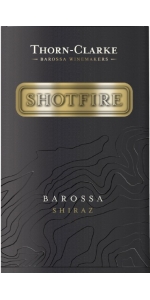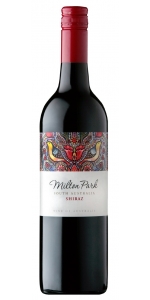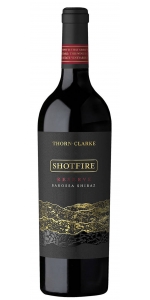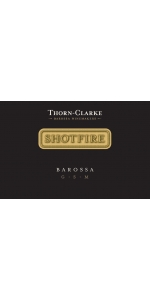Thorn Clarke Terra Barossa Shiraz Winemakers Selection 2010 (litre)
| Country: | Australia |
| Region: | Barossa Valley |
| Winery: | Thorn Clarke - Terra Barossa |
| Grape Type: | Shiraz |
| Vintage: | 2010 |
| Bottle Size: | 900 ml |
Thorn Clarke Shotfire Shiraz is made from 100% Shiraz.
Striking deep red-purple in color. A rich, voluptuous wine with aromas of blackcurrant and mulberries accompanied by notes of smokey oak and hints of cloves. The palate is filled with dark fruits and chocolate backed up by taut tannins and lingering oak.
Story:
When the Clarke forebearers discovered gold in 1870 at the Lady Alice mine in the Barossa goldfields, so began a family dynasty intrigued by geology. A fine legacy that is reflected today in the terroir of our vineyards. The Shotfire range immortalizes the Shotfirer's hazardous job of setting and lighting the charges in the mines.
Fran shares his story on how he discovered Thorn-Clarke:
"It was October 2001 and I was searching for and sourcing for Australian wines, as it was clear that Australia was going to become the "next big thing." After tasting about 100 assorted wines, I decided I liked the style of Barossa, Shiraz best - chocolate, cherries, mint and eucalyptus - so I started focusing on Barossa growers (years later, Barossa Shiraz would develop its reputation as the Icon Shiraz for Australia).
Late on a Thursday afternoon, the carrier delivered a beat-up box of 12 bottles from Australia, 10 of which were leaking. The box was from a guy named Steve Machin, who had just left Hardy's and was beginning work with the Clarke family on setting up a possible new brand. The samples were sticky and messy, but I popped the corks anyway ..... and I was glad that I did. The wine inside tasted like Christmas - mint, eucalyptus, camphor, and evergreen aromas. Great acidity, color, flavor and length of finish - very tasty. These samples were so good and so exciting, especially compared to what I had tasted prior, that I immediately called the number on the card. I didn't realize that it was a Perth number (Western Australia) and it was actually 3:00 in the morning. It turned out I was calling the residence of David and Cheryl Clarke, where a sleepy Cheryl answered the phone. I told her, you don't know who I am, but we are going to be doing business together very soon, and lots of it! After a few months of talking, faxing (yes, faxing) and sorting out the details, I began importing their wines.
That super-star wine from the busted box of samples is the wine we know today as Shotfire Shiraz. It was originally called Stone Jar, but fortunately we came up with a better name. Many years and vintages later, I'm still glad to be importing Shotfire Shiraz and other Thorn-Clarke selections .... and I'm still glad that Cheryl Clarke woke up for that phone call."
Thorn Clarke Shotfire Shiraz is made from 100% Shiraz.
Striking deep red-purple in color. A rich, voluptuous wine with aromas of blackcurrant and mulberries accompanied by notes of smokey oak and hints of cloves. The palate is filled with dark fruits and chocolate backed up by taut tannins and lingering oak.
Story:
When the Clarke forebearers discovered gold in 1870 at the Lady Alice mine in the Barossa goldfields, so began a family dynasty intrigued by geology. A fine legacy that is reflected today in the terroir of our vineyards. The Shotfire range immortalizes the Shotfirer's hazardous job of setting and lighting the charges in the mines.
Fran shares his story on how he discovered Thorn-Clarke:
"It was October 2001 and I was searching for and sourcing for Australian wines, as it was clear that Australia was going to become the "next big thing." After tasting about 100 assorted wines, I decided I liked the style of Barossa, Shiraz best - chocolate, cherries, mint and eucalyptus - so I started focusing on Barossa growers (years later, Barossa Shiraz would develop its reputation as the Icon Shiraz for Australia).
Late on a Thursday afternoon, the carrier delivered a beat-up box of 12 bottles from Australia, 10 of which were leaking. The box was from a guy named Steve Machin, who had just left Hardy's and was beginning work with the Clarke family on setting up a possible new brand. The samples were sticky and messy, but I popped the corks anyway ..... and I was glad that I did. The wine inside tasted like Christmas - mint, eucalyptus, camphor, and evergreen aromas. Great acidity, color, flavor and length of finish - very tasty. These samples were so good and so exciting, especially compared to what I had tasted prior, that I immediately called the number on the card. I didn't realize that it was a Perth number (Western Australia) and it was actually 3:00 in the morning. It turned out I was calling the residence of David and Cheryl Clarke, where a sleepy Cheryl answered the phone. I told her, you don't know who I am, but we are going to be doing business together very soon, and lots of it! After a few months of talking, faxing (yes, faxing) and sorting out the details, I began importing their wines.
That super-star wine from the busted box of samples is the wine we know today as Shotfire Shiraz. It was originally called Stone Jar, but fortunately we came up with a better name. Many years and vintages later, I'm still glad to be importing Shotfire Shiraz and other Thorn-Clarke selections .... and I'm still glad that Cheryl Clarke woke up for that phone call."
Thorn Clarke William Randell Shiraz is made from 100 percent Shiraz
The William Randell range of wines were created in honor of our family ancestor - the esteemed pioneer William Richard Randell (1824 - 1911). The wines are sourced solely from grapes grown on our estate vineyards. Wines in this range are only made in exceptional vintages.
Deep red with inky purple hues. This classic Barossa style shows rich blackberry, licorice, spice plum and smoky oak on the nose. The palate is dense with ripe mulberry and berry compote and generous supporting oak. The tannins are savory and long with spicy refined finish
Following harvest the fruit was crushed into a variety of small fermenters (4 to 6T in capacity). Fermentation was carried out at a warm temperature (25-28 degrees ). The ferments were manually pumped over to provide good control of tannin extraction. Each fermenter was treated as a separate parcel of wine and once dry was filled to American oak (40% new). Following malolactic fermentation the wines were racked and returned to the same oak. Parcels remained in barrel for an average of 18 months prior to blending. Only the best barrels from the multiple parcels were used to make the final blend. Once blended the wine was prepared for bottling.
Thorn Clarke Milton Park Shiraz is aged for 12 months in American oak barrels.
Deep red color. The wine is deep and rich smelling with dark fruits, plums and spice with some good oak. There is very rich fruit on the palate with plums, blackberry and sweet spice from the oak. The palate is vibrant and young with a flavorsome viscous mouthfeel which will develop complexity with time. There are some slightly chewy tannins which will soften with time and there is great length of fruit flavor.
Inky purple-red in color with intense depth to the rim. Aromas of sweet rich fruit and lifted cedar oak fill the glass. Abundant blackberry, violets and cigar box roll through the profile adding complexity and interest. The palate is round and silky with dark plum, liquorice, briar and blackberry primary fruits. The rich, toasty oak, and fleshy rounded tannins complete the palate of this dense, flowing wine. This poised and powerful wine is drinking amazingly well but with it's density and presence will cellar impeccably well.
Selected parcels of estate fruit were de-stemmed into our open fermenters and seeded with yeast. The ferments were pumped over twice daily to maximise color, tannin and flavor extraction. The temperature controlled fermenters allowed the ferments remain in the 22-25 °C range giving amazing fruit expression in the wine. Each parcel was pressed after a minimum of seven days fermenting on skins. The wine completed both primary and ML fermentation in tank before being filled to American oak hogsheads (300Ltrs) to mature. The wine was aged in a combination of new, 2nd and 3rd use barrels for up to 2 years. Prior to bottling the parcels were emptied from oak and
Rare roast beef or BBQ lamb cutlets
Review:
"Growers in Barossa for six generations, the Thorn-Clarke family farms close to 600 acres of vines, providing the fruit for this sleek, black-fruited shiraz. It’s silky- smooth, with the concentration and density of flavor that takes the tannins toward blood, iron and sage. A deep, dark wine with pleasure to spare, this begins to show floral scents of roses, then detailed flavors of plums and strawberries after a day open to air. - Joshua GREENE
- Wine & Spirits (December 2023), 93 pts
"Opaque dusty garnet color. Aromas and flavors of milk chocolate and coconut, blackberry syrup, eucalyptus, and pepper bbq sauce with a round, dry-yet-fruity full body and a hot, interesting, medium-long finish that exhibits notes of black berry bbq sauce, mint and eucalyptus, and chocolate sauce and vanilla with chewy, drying, coating tannins and light oak flavor. Knows that it is Barossa Shiraz and wears that moniker proudly tattooed as a sleeve; 10 out of 10 typicity here."
- Beverage Testing Institute (June 2023), 93 pts - GOLD MEDAL - Exceptional
Thorn Clarke Shotfire GSM is made from 51% Grenache, 39% Shiraz, 10% Mourvedre.
The Shotfire range honors a family pioneer who worked the Barossa goldfields in the late 1800's. He had the hazardous job of being a 'Shotfirer'; one who handled the explosives to be used in finding that rich vein of gold.
A classic blend of the traditional stalwarts from the Barossa, this blend of Grenache, Shiraz and Mourvèdre is sourced from older low yielding vines.
Bright crimson in color with purple highlights at the edge of the glass. The nose is lifted and draws you in with ripe plum, mulberry and white pepper. The palate is plush and vibrant with cherries, forest fruits and enticing spice. As silky and smooth as it is complex and savory - the wine is beautifully balanced and juicy with great structure and generous mouthfeel. This classic GSM finishes with long, velvety tannins.
Each variety was destemmed and fermented separately - in small 6 tonne open fermenters - to allow full expression of varietal character. To ensure optimum extraction of tannins, color and flavor the Grenache was pumped over twice daily for a duration of 10 days and both the Shiraz and Mourvedre spent 7 days on skins with pump overs twice daily. Fermentation temperatures were maintained between 22-25 degrees to retain fruit purity. All batches were pressed off and once both primary alcoholic fermentation and secondary malolactic fermentation were complete the wines were then racked to new (10%) and 10 year old French hogsheads where the wines matured for a period of 18 months. Bench blends were created to ensure a harmonious final wine.
Pairs best with slow Cooked Lamb or Roasted Vegetable Medley.
The Thorn Clarke Terra Barossa Shiraz Winemakers Selection palate is rich and full with spicy plums and creamy oak. The tannins are fine and give the wine great length of flavor and a superb smooth mouthfeel. Pairs well with foods with richness and flavor such as meat based pastaggg dishes, red meats or hard cheese.
The Thorn Clarke Terra Barossa Estate
The winery owners are David and Cheryl Clarke (born Thorn) and their son Sam is the manager of the winery. The Thorn-Clarke family has a long history in the Barossa - six generations of involvement in the region's world famous wine industry. The Thorns have been grape growers in the Barossa since the 1870's. David Clarke's passion for the wine industry lead to the planting of the Kabininge vineyard outside of Tanunda in 1987, which represents the start of a deeper involvement by the family in the Barossa wine industry.
The Thorn Clarke Terra Barossa Vineyards
Terra Barossa pays tribute to the rich, fertile soils of the region which contribute to wines of such great character. The free draining soil structure combined with the continental climate of warm days and cool nights enables them to produce elegant wines with good varietal character.
- back
Corne Loup Lirac Rouge is made from 50% Grenache, 40% Syrah and 10% Mourvedre
Dry - less than 4 grams/liter
Color: dark red ruby.
Aromas: red berries, truffles and spices.
Flavors: complex and rich. It shows red and black fruits, with an herbal spice type of aromas coming from the surrounding vegetation (Garrigue).
The average age of the vines is 40 years. (The oldest vines are 80 years old).
The soil is mainly sandy marl and small pebble stones.
Pairs with lamb, duck, turkey, red meat, game and cheese.
Torello Corpinnat Finca Can Marti Brut 32% Chardonnay, 32% Xarel.lo, 22% Macabeo and 14% Parellada.
The Can Martí estate soils have been formed from sediments from the Garraf Massis, deposited thousands of years ago. One of the most characteristic features of the estate’s soils is the presence of accumulations of calcium carbonate.The movement of water through the soil dissolves the carbonates present and takes them to a certain depth. The continuous repetition of this process has ended up producing the accumulation of these deposits.When these become massive, after thousands of years, they bind together and and form a hard stratum called a petrocalcic horizon. This hard stratum limits the availbility of water to the vine and the production, but is a factor that gives the grape quality.
Straw yellow color, fine and constant bubbles, clean and bright, with golden reflections. The nose reveals a subtle aromatic intensity with fresh and sweet aromas. Honey flowers, citrus notes, white fruit, and balsamic herbs such as fennel.
In the mouth the acidity is well balanced, with delicate bitter notes to the finish and a set of ripe fruits and balsamic nuances.










